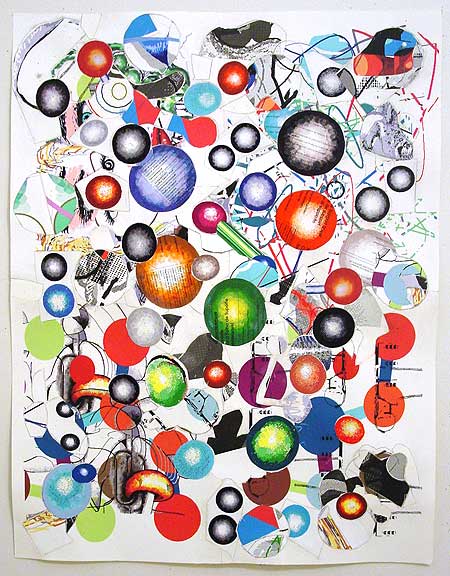
paper, ink, linen tape, 22 x 17 inches
(posted earlier, have continued to work on it)
An animated GIF showing the changes since first posted: [.5 MB .gif] (the GIF isn't really art, just a studio record that helps me figure out if the piece is finished--I think it is)
Each change involves cutting out existing paper, inlaying new paper and retaping from behind.
The GIF is an animated record of the changes but the piece shows a physical record in the form of fairly rough cutting and seaming. The paper and tape are thick; an X-acto knife is used to saw through it with less than surgical precision.
An artist asked for images of mine for a gallery of digital artists. I thanked him but said I wasn't really a digital artist, that there is all this physical process that reproductions don't show very well.
He said I should stop "hiding" the digital nature of my work. Well, if anything, I'm hiding the analog side because it doesn't translate well to the web.
People have asked, why the molecules? (one writer said they look like giant gumballs). In this case I envisioned an experiment gone wrong, a perfect order breaking down as unexplained forces metastasize the "atoms." The text on some of the balls is the Epson loading support sheet that inadvertently got printed on, so real accidents happen as well. I see the imagery as attractive and repulsive though some will only be repulsed, or nonplussed.
I am also inspired by something the artist Charles Long said about his installation "Bubble Gum Station." He talked about how in classrooms children are engaged in intense learning and memorizing of science and language data that prepare them to enter the modern world. Meanwhile, like the Freudian unconscious, these gooey shapes of bubble gum are accumulating under their chairs, mingling--the complete opposite of the dry abstractions being exchanged topside.
My "digital" art has a literal flip side, which is a messy network of cotton tape applied with finger pressure and water. By necessity this is not seen but only implied from the front of the piece, viewed in person. That's actually much harder for me to deal with or understand with than any sort of "digital" nature.
